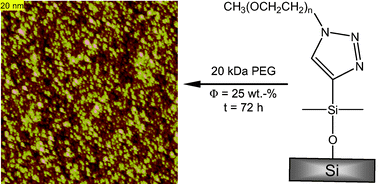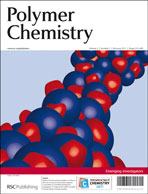The grafting of poly(ethylene glycol) (PEG) brushes to silicon substrates by the copper(I)-catalyzed Huisgen 1,3-dipolar cycloaddition, also coined as click chemistry, was studied in detail. First, the grafting kinetics of an alkyne-functionalized dimethylchlorosilane SAM from a toluene solution or in the vapor phase was monitored by water contact angle measurements. α-Methoxy-ω-azido-PEGs with Mw of 5, 20, and 50 kDa were then grafted to the alkyne functionalized SAMs via click chemistry in THF using Cu(PPh3)3Br/DIPEA as the catalytic system. The influence of polymer concentration in the grafting solution (Φ = 0.01–50 wt%) and reaction time (t = 0–72 h) on the thickness, morphology and wetting properties of the PEG brushes was investigated by ellipsometry, scanning probe microscopy and water contact angle measurements. PEG brushes up to 6 nm thick with homogeneous surface coverage and morphology as well as surface roughness on a nanometric scale were thus obtained using mild and robust grafting conditions.

You have access to this article
 Please wait while we load your content...
Something went wrong. Try again?
Please wait while we load your content...
Something went wrong. Try again?


 Please wait while we load your content...
Please wait while we load your content...